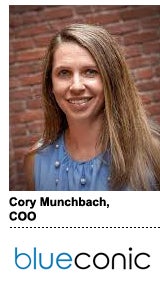This is the 13th installment in AdExchanger’s “Meet the CDPs” series. Read previous interviews with mParticle, Acquia-owned AgilOne, Amperity, Segment, ActionIQ, Lytics, Bluecore, Microsoft, Tealium, Optimove, Adobe and Treasure Data.
The marketing clouds are taking up a lot of mindshare as they belatedly foray into the CDP category.
But “you’d be surprised at the number of RFPs we’re involved in where the company already has a Salesforce Marketing Cloud implementation and yet they’re still looking for a CDP,” said Cory Munchbach, chief operating officer at customer data platform BlueConic.
Officially, that puts BlueConic in competition with the marketing clouds, but it’s far from an apples-to-apples comparison, she said.
“The marketing clouds don’t have a shared backend data infrastructure across the disparate functions and tools they’ve purchased over the years,” said Munchbach, who joined BlueConic in 2015 after nearly five years as an analyst at Forrester.
“It’s an architectural choice that sets CDPs apart from the marketing clouds,” she said. “A CDP isn’t just an analysis tool or another database; we’re designed to bring data to marketers in a way that aligns with their use cases.”
BlueConic has more than 300 customers globally, including Bob’s Discount Furniture, Moen, T-Mobile, ING, Hearst, The Boston Globe and National Review. The company has 100 employees, with roughly 35% on the product team, and raised a $12.8 million Series B in January, bringing its total funding to $25 million.
Munchbach spoke with AdExchanger.
AdExchanger: Did BlueConic start as a CDP from Day One?
CORY MUNCHBACH: We were a CDP before we had the language to describe it, and we exist because there’s always been a huge chasm between first-party data assets. This has been a problem, whether you want to be able to do personalization in the moment or you need to know your customer’s backstory so you can know what to do next.
Web and mobile are the most problematic journeys because they move so quickly. People advance through the journey in a matter of seconds. Other marketing channels – email, for example – don’t have quite that level of intensity.
BlueConic was always about increasing the adjacency of that data to where it’s being activated.
Who is your typical customer, and what problems are they trying to solve?
It’s mainly B2C marketers with a lot of first-party data that’s often coming in from different places and they don’t have a good grip on it. We’re strong in publishing, manufacturing, DTC and brick-and-mortar, but our sweet spot is multi-region organizations with multiple brands, diverse marketing programs and a structural divide in how their data is organized.
Are any of your clients looking for help with data governance, particularly as privacy and data security become bigger issues?
It’s becoming high on the priority list of requirements for CDPs and it’s come up in every evaluation we’ve been a part of over the past 12 to 18 months. Marketing plays a big role here. I can see a world in which we need to collect consent on a much more regular basis than a one-time opt-out for cookies.
We have a Belgian multibrand client that has 37,000 profiles in a database that they’re able to update with consent information in milliseconds. That means they can respond to requests with a high level of granularity without disrupting the customer experience. Data governance is about winning the front end – and the back end – of data management.
What does the death of the third-party cookie mean for CDPs?
The CDP is one piece of this puzzle. The death of third-party cookies will create a significant ripple effect in terms of how marketers need to think about consumer engagement, and that is going to start with accurate, consented data that gets treated like the asset it is.
How long does it take to onboard a new customer?
For enterprise brands, the average implementation is three to four months. For small to midsize organizations with less complex data and fewer data sources, it can be six to eight weeks.
But I really like the idea of measuring this in a more nuanced way. There’s time to access, which is how quickly we can get the data in your hands, which is usually a matter of weeks. But the more important question is time to value – how long until you see an impact on operational efficiency outside of improving the core marketing metrics. I’d love to be in a world where we’re judged on metrics beyond improving CTR or dollars per email.
Better data equals better outcomes – that’s a 2010-era argument. Now, we need to think more strategically about improving the operational metrics of a business. For example, can I do this at scale? Can I free up a marketer’s time? The time-to-value conversation is one that we’re having a lot more these days in light of COVID.
As a former analyst, you’ve got a well-honed BS detector. What are the telltale signs of a company claiming to be a CDP, but that isn’t really one?
Where do you store the data and are you actually managing the data or is that outsourced? If you don’t have a database or an infrastructure to access it directly, then you’re not a CDP.
Another big piece of this is how much is available out of the box. We see a lot of marketing service providers claiming to be a CDP … but then it’s, oh yeah, we just have to build everything for you first if it’s going to work.
This interview has been edited and condensed.














